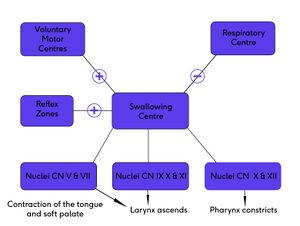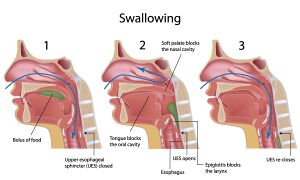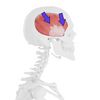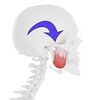The Relationship Between Posture and Swallowing: Difference between revisions
No edit summary |
No edit summary |
||
| Line 49: | Line 49: | ||
== Phases of Swallowing == | == Phases of Swallowing == | ||
=== Oral Phase (preparatory and propulsive)<ref>Costa MMB. [https://www.scielo.br/j/ag/a/KSKwC9f7JRqtDxntLyCbksS/?lang=en Neural Control of Swallowing]. Arq Gastroenterol. 2018; | === Oral Phase (preparatory and propulsive)<ref>Costa MMB. [https://www.scielo.br/j/ag/a/KSKwC9f7JRqtDxntLyCbksS/?lang=en Neural Control of Swallowing]. Arq Gastroenterol. 2018;55(Suppl 1):61-75. </ref><ref name=":4">Palmer JB, Drennan JC, Baba M. [[Palmer JB, Drennan JC, Baba M. Evaluation and treatment of swallowing impairments. Am Fam Physician. 2000 Apr 15;61(8):2453-62. PMID: 10794585.|Evaluation and treatment of swallowing impairments]]. Am Fam Physician. 2000 Apr 15;61(8):2453-62. </ref> === | ||
* The oral phase starts when food enters the mouth<ref name=":5">Reboredo V. Physiology of the Temporomandibular Joint Course. Physioplus, 2021.</ref> | * The oral phase starts when food enters the mouth<ref name=":5">Reboredo V. Physiology of the Temporomandibular Joint Course. Physioplus, 2021.</ref> | ||
Revision as of 11:04, 10 July 2021
Top Contributors - Jess Bell, Kim Jackson, Tarina van der Stockt, Lucinda hampton and Kirenga Bamurange Liliane
Introduction[edit | edit source]
Deglutition (i.e. swallowing) enables food to move from the mouth to the stomach, via the pharynx and oesophagus.[1]
There is evidence to suggest that swallowing begins to develop in utero from 15 weeks gestation.[1] Swallowing actions (such as sucking, swallowing and the breathing sequence) continue to evolve after birth as babies are introduced to new food and start to exercise conscious control over their swallowing.[1] Our ability to swallow continues to change as we age, eventually leading to swallowing disorders in some adults.[2]
Deglutition and Posture[edit | edit source]
Deglutition has a direct impact on the postural system.[3][4]
- Alghadir and colleagues found that when the tongue is positioned against the upper incisors, postural stability is enhanced in young adults when they are standing on unstable surfaces or are without visual cues[5]
- Wildenberg and colleagues found that electrical stimulation of the tongue had a positive effect on balance, gait, and posture in patients who had with postural dysfunction[6]
The tongue is considered the first structure to stimulate the postural chains. The input from the feet becomes more important when a child is able to maintain an upright position and begin walking.[3]
The pattern of the deglutition changes from childhood to adulthood:[3]
- Children apply forces of up to 300g when chewing whereas adults can apply 3kg of force
The deglutition cycle is repeated thousands of times each day in all positions (standing, sitting, sleeping etc). Every time an individual swallows (starting in utero), increased force is applied to his / her teeth and cranial system.[3] The forces applied during childhood, particularly those generated by the masticatory muscles, are believed to be associated with an adult’s facial features.[7]
Palatine Spot[edit | edit source]
The palatine spot is on the roof of the mouth (i.e. palate). It corresponds with the palatine bone, between the interdental papillam(i.e. gum tissue between the teeth) of the top front teeth and the first fold of the palate.[8] This spot has a large number of trigeminal nerve endings and exteroceptors.[4]
Correct stimulation of the palatine spot helps to inform postural control centres about relevant anatomical structures (e.g. the teeth, arches of the teeth, head position etc).[3]
Red Flags[edit | edit source]
Whenever assessing swallowing, it is essential to screen for red flags, including neurological and degenerative pathologies (e.g. multiple sclerosis, amyotrophic lateral sclerosis (ALS), myasthenia gravis etc). In cases where there is a loss of strength related to a central deficit, it is important to aim for active motor coordination and allow for necessary postural compensations. The goal is not to achieve the optimal normal position, but to maintain residual function.[3]
Posture Assessment[edit | edit source]
The assessment of posture is discussed here. These same tests can be repurposed to see how the system changes in response to deglutition.[3]
- Look for any compensation during swallowing - is the head in the correct position? Is there a forward head position?[3]
- When posture is corrected, observe if deglutition is: [3]
- Possible
- Possible, but only with difficulty
- Impossible
- NB If it is impossible to correct the client’s position and achieve a swallow, it will be necessary to consider the role of each member of the MDT (e.g. speech therapists, physiotherapists and manual therapists).[3]
- Consider the possibility of paralysis (e.g. to cranial nerve VII / facial nerve) noting that the degree and severity of this paralysis can vary between patients.
Pattern of Deglutition[edit | edit source]
As is highlighted in Figure 1, swallowing centres activate the voluntary motor centres and inhibit the respiratory centres - this prevents food entering the trachea. There is also activation of the reflex centres, and of the nuclei of the cranial nerves that are involved in the movement of the tongue, the larynx and the pharynx.[3]
Phases of Swallowing[edit | edit source]
Oral Phase (preparatory and propulsive)[9][10][edit | edit source]
- The oral phase starts when food enters the mouth[11]
- The lips close and and the tongue forms a seal to prevent the food (which is being transformed into a bolus) from falling out of the mouth[11]
- The bolus is formed through the movement of the lips, jaw, cheeks and tongue[12]
- Once the bolus is safe to be swallowed, it is pushed backwards by the tongue to the pharynx[12]
- During this phase, significant force is applied to the dental arches (upper and lower teeth)[3]
- Activity in the posterior cervical postural chains is initiated[3]
- The glands play an important role in the preparation of the bolus:
- Around 90 percent of saliva is released by the parotid, submandibular and the sublingual glands
- The other 10 percent is released by minor glands found throughout the oral cavity[13]
- The second part of the oral phase is the transportation of the bolus posteriorly to the pharynx:[3]
- This requires lingual coordination and pharynx contraction
- It creates a vacuum effect
- The autonomic system controls the actions of the veil of the palate (i.e. soft palate), pharyngeal muscles and the oesophageal sphincter
Pharyngeal Phase[edit | edit source]
- The pharyngeal phase refers to the movement of the bolus through the pharynx[12]
- During this phase, the airway is also protected from the bolus
- The bolus moves from the base of the tongue to the wall of the posterior pharynx
- In order to achieve this, the following overlapping steps occur:[3][10]
- The palatopharyngeal sphincter[14] opens
- The soft palate rises
- The larynx and hyoid move upwards and forwards
- The vocal folds move into the midline and the epiglottis moves back, thus protecting the airway
- The tongue pushes the bolus down
- The upper oesophageal sphincter opens
Oesophageal Phase[edit | edit source]
- This phase begins once the bolus passes through the opened upper oesophageal sphincter[11]
- Peristalsis pushes the bolus down to the stomach via the lower oesophageal sphincter[12] - this is controlled by the sympathetic nervous system[3]
See Figure 2 for an image of the stages of swallowing.
Effects of Posture[edit | edit source]
Head and neck posture and anterior cervical muscle tone can have a negative impact on swallowing.[15]
Different body positions can also affect an individual’s self-perceived difficulty while swallowing.[16] In a study by Alghadir and colleagues, it was found that:[16]
- Swallowing is easier in an upright sitting position for healthy adults
- There were statistically significant differences in ease of swallowing between sitting upright, sitting with head / neck flexed, head / neck extended and lying supine
- Swallowing while sitting with head and neck in extension was the most difficult posture
- Because the chin tuck position widens the vallecular space and narrows the airway entrance narrow to prevent aspiration, this position is often used to help patients achieve swallowing and prevent aspiration
Some points to consider:[3]
- The stylohyoid muscles and the pharynx constrictors traction the laryngeal compartment causing it to elevate
- The pharyngeal aponeuroses attach at the level of the pharyngeal tubercle of the occipital bone
- Traction of the pharangeal aponeurosis, therefore, occurs anteriorly to the C0-C1 joints
Factors that Potentially Interfere with Swallowing[edit | edit source]
The following issues can interfere with swallowing during the oral phase:[3]
- Malocclusion
- Dental problems
- Trigger points on the masticatory muscles
- Temporomandibular joint dysfunction
- Effects of parafunctions (e.g. suboccipital or cervical muscle tension)
- Postural compensation
- Neurodegenerative changes
The following issues or structures can interfere with the oral propulsive phase of swallowing:[3]
- The cranial nerves
- The tongue and floor of the mouth
- Infantile (or visceral) swallowing
- A type of swallow characterised by a forward movement of the tongue tip
- Present at birth until after the fourth year, but it is considered dysfunctional because it is associated with malocclusion[17]
- Incorrect movement of the soft palate
- Lingual pattern
The following issues or structures can interfere with the pharangeal and oesophageal phases of swallowing:[3]
- Pharyngeal-laryngeal muscle patterns
- Soft palate
- Larynx (potential traction from the myofascial system)
- Oesophagus
Tongue and Hyoid[edit | edit source]
The tongue has a significant role in a number of functions, including swallowing, breathing, speaking and mastication.[4] The tongue is in contact with the hyoid bone through the hyoid musculature (i.e. suprahyoid and infrahyoid muscles).[3][4] Thus, through these muscles, the tongue has a relationship with the head during various neck movements.[4]
Suboccipital Adaptation[edit | edit source]
The suboccipital muscles act to maintain the horizontal posture of the head, in synergy with global chains and in relation to input from the visual, mandibular and swallowing systems.[3]
Forces and Bone Evolution[edit | edit source]
Cranial growth is regulated by the biomechanics of the bone growth nuclei and cranial sutures. Incorrect stimuli during childhood could lead to asymmetric cranial development.[3] Chewing and swallowing forces can directly affect facial growth while masticatory forces have a direct impact on the TMJ system.[3][7]
- Muscles of mastication can apply significant force to the cranial bones:
- Contact between the dental arches causes extension of the occiput (i.e. posterior traction)
- Sternocleidomastoid (see Figure 5) plays an important role in stabilising the head and causes posterior rotation of the temporal bone[3]
References[edit | edit source]
- ↑ 1.0 1.1 1.2 Panara K, Ramezanpour Ahangar E, Padalia D. Physiology, Swallowing. [Updated 2020 Aug 21]. In: StatPearls [Internet]. Treasure Island (FL): StatPearls Publishing; 2021 Jan-. Available from: https://www.ncbi.nlm.nih.gov/books/NBK541071/
- ↑ Kletzien H, Cullins MJ, Connor NP. Age-related alterations in swallowing biomechanics. Exp Gerontol. 2019;118:45-50.
- ↑ 3.00 3.01 3.02 3.03 3.04 3.05 3.06 3.07 3.08 3.09 3.10 3.11 3.12 3.13 3.14 3.15 3.16 3.17 3.18 3.19 3.20 3.21 3.22 3.23 3.24 3.25 Banfi M. Deglutition Course. Physioplus, 2021.
- ↑ 4.0 4.1 4.2 4.3 4.4 Bordoni B, Morabito B, Mitrano R, Simonelli M, Toccafondi A. The anatomical relationships of the tongue with the body system. Cureus. 2018;10(12):e3695.
- ↑ Alghadir AH, Zafar H, Iqbal ZA. Effect of tongue position on postural stability during quiet standing in healthy young males. Somatosens Mot Res. 2015;32(3):183-6.
- ↑ Wildenberg JC, Tyler ME, Danilov YP, Kaczmarek KA, Meyerand ME. Sustained cortical and subcortical neuromodulation induced by electrical tongue stimulation. Brain Imaging Behav. 2010;4(3-4):199-211.
- ↑ 7.0 7.1 Inoue M, Ono T, Kameo, Y, Sasaki F, Ono T, Adachi T et al. Forceful mastication activates osteocytes and builds a stout jawbone. Sci Rep. 2019;9:4404.
- ↑ di Vico R, Ardigò LP, Salernitano G, Chamari K, Padulo J. The acute effect of the tongue position in the mouth on knee isokinetic test performance: a highly surprising pilot study. Muscles Ligaments Tendons J. 2014;3(4):318-23.
- ↑ Costa MMB. Neural Control of Swallowing. Arq Gastroenterol. 2018;55(Suppl 1):61-75.
- ↑ 10.0 10.1 Palmer JB, Drennan JC, Baba M. Evaluation and treatment of swallowing impairments. Am Fam Physician. 2000 Apr 15;61(8):2453-62.
- ↑ 11.0 11.1 11.2 Reboredo V. Physiology of the Temporomandibular Joint Course. Physioplus, 2021.
- ↑ 12.0 12.1 12.2 12.3 Holland G. The relationship between oral stereognosis and functional measures of swallowing [dissertation]. Christchurch: University of Canterbury. 2020.
- ↑ Bornhorst GM, Singh RP. Bolus formation and disintegration during digestion of food carbohydrates. Comprehensive Reviews in Food Science and Food Safety. 2012;11:101-18.
- ↑ Sumida K, Ando Y, Seki S, Yamashita K, Fujimura A, Baba O, Kitamura S. Anatomical status of the human palatopharyngeal sphincter and its functional implications. Surg Radiol Anat. 2017 Nov;39(11):1191-201.
- ↑ Yamazaki Y, Tohara H, Hara K, Nakane A, Wakasugi Y, Yamaguchi K et al. Excessive anterior cervical muscle tone affects hyoid bone kinetics during swallowing in adults. Clin Interv Aging. 2017;12:1903-10.
- ↑ 16.0 16.1 Alghadir AH, Zafar H, Al-Eisa ES, Iqbal ZA. Effect of posture on swallowing. Afr Health Sci. 2017;17(1):133-137. doi:10.4314/ahs.v17i1.17
- ↑ Peng CL, Jost-Brinkmann PG, Yoshida N, Miethke RR, Lin CT. Differential diagnosis between infantile and mature swallowing with ultrasonography. Eur J Orthod. 2003;25(5):451-6.
- ↑ 18.0 18.1 Mao JJ, Wang X, Kopher RA. Biomechanics of craniofacial sutures: orthopedic implications. Angle Orthod. 2003;73(2):128-35.











